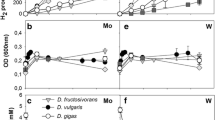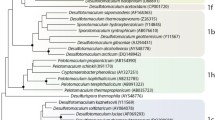Abstract
Growth of Desulfotomaculum orientis, D. ruminis, D. nigrificans and the Desulfotomaculum strains TEP, TWC and TWP, that were newly isolated with sulfate and fatty acids, was studied using defined mineral media. Four of these strains grew with hydrogen plus sulfate as the only energy source. Under these conditions the growth yield of D. orientis in batch culture was 7.5 g cell dry mass per mol sulfate reduced. Growth on methanol with growth yields of about 6 g cell dry mass per mol sulfate was obtained with D. orientis and strain TEP. All strains tested grew slowly with formate as electron donor. Fatty acids from propionate to palmitate were utilized by the strains TEP, TWC and TWP. D. orientis and the strains TEP and TWC were able to utilize the methoxyl groups of trimethoxybenzoate for growth. D. orientis was found to grow chemoautotrophically with hydrogen, carbon dioxide and sulfate; during growth with C1-compounds no additional organic carbon source was required. Furthermore, D. orientis was able to grow slowly in sulfate-free medium with formate, methanol, ethanol lactate, pyruvate or trimethoxybenzoate. Under these conditions acetate was excreted, indicating the function of carbon dioxide as electron acceptor in a homoacetogenic process. A growth-promoting effect of pyrophosphate added to the medium of Desulfotomaculum species was not observed. The results show a high catabolic and anabolic versatility among Desulfotomaculum species, and indicate that electron transport to sulfate can be the sole energy conserving process in this genus.
Similar content being viewed by others
References
Adams ME, Postgate JR (1959) A new sulphate-reducing vibrio. J Gen Microbiol 20:252–257
Akagi JM, Jackson G (1967) Degradation of glucose by proliferating cells of Desulfotomaculum nigrificans. Appl Microbiol 15:1427–1430
Badziong W, Thauer RK (1978) Growth yields and growth rates of Desulfovibrio vulgaris (Marburg) growing on hydrogen plus sulfate and hydrogen plus thiosulfate as the sole energy sources. Arch Microbiol 117:209–214
Badziong W, Thauer RK (1980) Vectorial electron transport in Desulfovibrio vulgaris (Marburg) growing on hydrogen plus sulfate as sole energy source. Arch Microbiol 125:167–174
Brandis A, Thauer RK (1981) Growth of Desulfovibrio species on hydrogen and sulphate as sole energy source. J Gen Microbiol 126:249–252
Brandis-Heep A, Gebhardt NA, Thauer RK, Widdel F, Pfennig N (1983) Anaerobic acetate oxidation to CO2 by Desulfobacter postgatei. 1. Demonstration of all enzymes required for the operation of the citric acid cycle. Arch Microbiol 136:222–229
Braun M, Mayer F, Gottschalk G (1981) Clostridium aceticum (Wieringa) a microorganism producing acetic acid from molecular hydrogen and carbon dioxide. Arch Microbiol 125:288–293
Bryant MP, Campbell LL, Reddy CA, Crabill MR (1977) Growth of Desulfovibrio in lactate or ethanol media low in sulfate in association with H2-utilizing methanogenic bacteria. Appl Environ Microbiol 33:1162–1169
Budini R, Tonelli D, Girotto S (1980) Analysis of total phenols using the prussian blue method. J Agric Food Chem 28:1236–1238
Butlin KR, Adams ME (1947) Autotrophic growth of sulphatereducing bacteria. Nature 160:154–155
Campbell LL, Frank HA, Hall ER (1957) Studies on thermophilic sulfate-reducing bacteria. I. Identification of Sporovibrio desulfuricans as Clostridium nigrificans. J Bacteriol 73:516–521
Campbell LL, Postgate JR (1965) Classification of the sporeforming sulfate-reducing bacteria. Bacteriol Rev 29:359–363
Cline E (1969) Spectrophotometric determination of hydrogensulfide in natural waters. Limnol Oceanogr 14:454–458
Coleman GS (1960) A sulphate-reducing bacterium from the sheep rumen. J Gen Microbiol 22:432–436
Diekert G, Ritter M (1983) Carbon monoxide fixation into the carboxyl group of acetate during growth of Acetobacterium woodii on H2 and CO2. FEMS Microbiol Lett 17:299–302
Diekert G, Hansch M, Conrad R (1984) Acetate synthesis from 2 CO2 in acetogenic bacteria: Is carbon monoxide an intermediate? Arch Microbiol 138:224–228
Eichler B, Schink B (1984) Oxidation of primary aliphatic alcohols by Acetobacterium carbinolicum sp. now., a homoacetogenic anaerobe. Arch Microbiol 140:147–152
Fowler VJ, Widdel F, Pfennig N, Woese CR, Stackebrandt E (1985) Phylogenetic relationships of sulfate-and sulfur-reducing eubacteria. System Appl Microbiol (in press)
Gebhardt NA, Linder D, Thauer RK (1983) Anaerobic acetate oxidation to CO2 by Desulfobacter postgatei. 2. Evidence from 14C-labelling studies for the operation of the citric acid cycle. Arch Microbiol 136:230–233
Iizuka H, Okazaki H, Seto N (1969) A new sulfate-reducing bacterium isolated from antarctica. J Gen Appl Microbiol 15:11–18
Jansen K, Thauer RK, Widdel F, Fuchs G (1984) Carbon assimilation pathways in sulfate-reducing bacteria. Formate, carbon dioxide, and acetate assimilation by Desulfovibrio baarsii. Arch Microbiol 138:257–262
Liu C-L, Peck HD Jr (1981) Comparative bioenergetics of sulfate reduction in Desulfovibrio and Desulfotomaculum spp. J. Bacteriol 145:966–973
Liu C-L, Hart N, Peck HD Jr (1982) Inorganic pyrophosphate: Energy source for sulfate-reducing bacteria of the genus Desulfotomaculum. Science 217:363–364
Ljungdahl LG, Wood HG (1982) Acetate biosynthesis. In: Dolphin D (ed) B12, vol 2. John Wiley & Sons, New York, pp 165–202
Lupton FS, Conrad R, Zeikus JG (1984) CO metabolism of Desulfovibrio vulgaris strain Madison: Physiological function in the absence or presence of exogeneous substrates. FEMS Microbiol Lett 23:263–268
Nazina IN, Pivovarova TA (1979) Submicroscopic organization of the sporulation in Desulfotomaculum nigrificans. Microbiologiya (Engl. translation) 48:303–306
Nethe-Jaenchen R, Thauer RK (1984) Growth yields and saturation constant of Desulfovibrio vulgaris in chemostat culture. Arch Microbiol 137:236–240
Peck HD Jr (1960) Evidence for oxidative phosphorylation during the reduction of sulfate with hydrogen by Desulfovibrio desulfuricans. J Biol Chem 235:2734–2738
Peck HD Jr (1966) Phosphorylation coupled with electron transfer in extracts of the sulfate reducing bacterium Desulfovibrio gigas. Biochem Biophys Res Commun 32:112–118
Peck HK Jr, LeGall J (1982) Biochemistry of dissimilatory sulphate reduction. Phil Trans R Soc Lond B298:443–466
Pfennig N (1978) Rhodocyclus purpureus gen. nov. and sp. now., a ring-shaped, vitamin B12-requiring member of the family Rhodospirillaceae. Int J Syst Bacteriol 28:283–288
Postgate JR (1984) The sulphate-reducing bacteria. 2nd ed, Cambridge University Press, Cambridge UK
Schink B, Pfennig N (1982) Fermentation of trihydroxybenzenes by Pelobacter acidigallici gen. nov. sp. nov., a new strictly anaerobic non-spore-forming bacterium. Arch Microbiol 133:195–201
Sleytr K, Adam H, Klaushofer H (1969) Die Feinstruktur der Zellwand und Cytoplasmamembran von Clostridium nigrificans dargestellt mit Hilfe der Gefrierätz-und Ultradünnschnitttechnik. Arch Mikrobiol 66:40–58
Stupperich E, Hammel KE, Fuchs G, Thauer RK (1983) Carbon monoxide fixation into the carboxyl group of acetyl coenzyme A during autotrophic growth of Methanobacterium. FEBS Lett 152:21–23
Tabatabai MA (1974) Determination of sulfate in water samples. Sulphur Inst J 10:11–13
Trudinger PA (1970) Carbon monoxide-reacting pigment from Desulfotomaculum nigrificans and its possible relevance to sulfite reduction. J Bacteriol 104:158–170
Tschech A, Pfennig N (1984) Growth yield increase linked to caffeate reduction in Acetobacterium woodii. Arch Microbiol 137:163–167
Widdel F, Pfennig N (1977) A new anaerobic, sporing, acetateoxidizing, sulfate-reducing bacterium, Desulfotomaculum (emend.) acetoxidans. Arch Microbiol 112:119–122
Widdel F, Pfennig N (1981a) Sporulation and further nutritional characteristics of Desulfotomaculum acetoxidans. Arch Microbiol 129:401–402
Widdel F, Pfennig N (1981b) Studies on dissimilatory sulfate-reducing bacteria that decompose fatty acids. I. Isolation of new sulfate-reducing bacteria enriched with acetate from saline environments. Description of Desulfobacter postgatei gen. nov. sp. nov. Arch Microbiol 129:395–400
Widdel F, Kohring GW, Mayer F (1983) Studies on dissimilatory sulfate-reducing bacteria that decompose fatty acids. III. Characterization of the filamentous gliding Desulfonema limicola gen. nov. sp. nov., and Desulfonema magnum sp. nov. Arch Microbiol 134:286–294
Wieringa KT (1940) The formation of acetic acid from carbon dioxide and hydrogen by anaerobic spore-forming bacteria. Antonie van Leeuwenhoek J Microbiol Serol 6:251–262
Author information
Authors and Affiliations
Rights and permissions
About this article
Cite this article
Klemps, R., Cypionka, H., Widdel, F. et al. Growth with hydrogen, and further physiological characteristics of Desulfotomaculum species. Arch. Microbiol. 143, 203–208 (1985). https://doi.org/10.1007/BF00411048
Received:
Accepted:
Issue Date:
DOI: https://doi.org/10.1007/BF00411048




